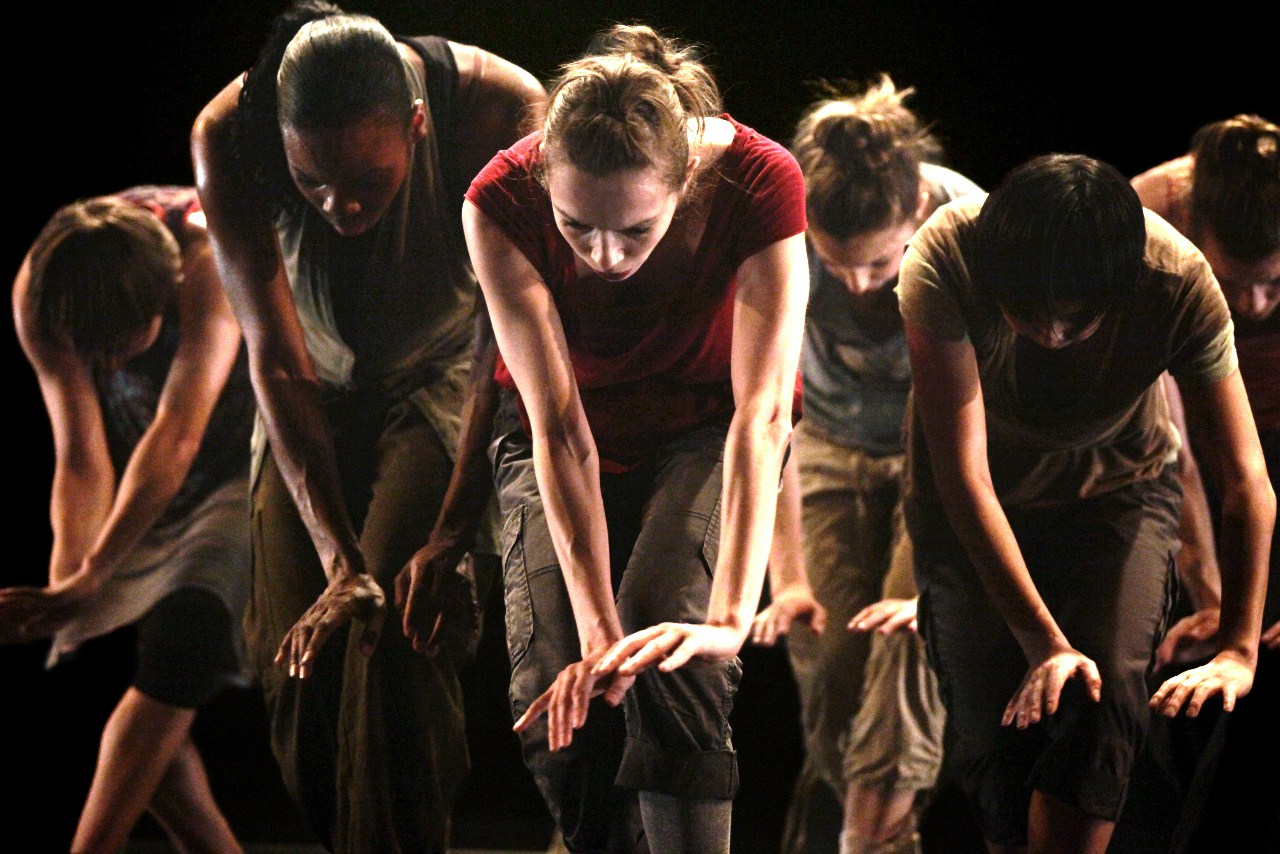Twenty seconds into Cedar Lake’s first piece, “Violet Kid,” at their June 2, 2012 performance at Gaillard Auditorium during Spoleto U.S.A. in Charleston, SC, tears were pouring down my face. The choreography, full of licks descended from the hallowed ground of high-end, post-modern release technique – blisteringly physical and intellectual – was so unbelievably GOOD.
Maybe you’ve seen the 2011 Matt Damon movie, The Adjustment Bureau? Damon’s love interest, played by Emily Blunt, leads a dance company in NYC called Cedar Lake, and he spends half the film shouting, “Where is Cedar Lake!” in an effort to find her while eluding guys in fedoras. Well, he finds her, spending a quiet moment marveling as the Cedar Lake dance company performs. This performance is so very, very good that I found myself marveling, too. It was like nothing I’d seen in a “non-dance” movie since a few snippets in the 1996 Bertolucci film Stealing Beauty. (Remember that?)
When my Spoleto 2012 program arrived in the mail, mere days after my catching The Adjustment Bureau on cable, how stoked was I that Cedar Lake Contemporary Ballet was coming to SC? Pretty stoked. Bought tickets immediately. (Talk about effective brand placement in a film, no?)
Led by Artistic Director Benoit-Swan Pouffer and based in New York City, Cedar Lake’s mission is “to provide choreographers a comprehensive environment for creation and presentation.” Noted by Kinsey Gidick, reporting for Charleston City Paper from the after party the night of June 2 at the College of Charleston President’s House, “The beauty of Cedar Lake is that Walmart heiress and founder, Nancy Walton Laurie, has been insistent that her performers be able to do contemporary ballet as a full-time job, which is to say the cast members live in New York City and don't have to have second and third jobs to survive.”
Guest choreographer Hofesh Schecter, who designed or collaborated on every aspect of “Violet Kid” including the stark, cinematic lighting, edgy music, and everyday costumes, somehow managed to fit all of the absolutely coolest, best parts of post-modern technique and composition into one great, glorious 33-minute piece for 14 dancers. Virtuosic athleticism. Focused, unemotional execution. Intricate, pedestrian movement vocabulary, manipulated into dozens of phrases which were then deconstructed and reassembled into even more variations. Each piece was revisited and made large, small, narrowing, expanding, rising, sinking, slow, fast, impossibly fast, and every other Laban Movement Analysis term I can remember from my dance degree studies at Wesleyan University. This piece used every compositional tool in the box, and thoroughly. What a pleasure to watch.
A consistent return to familiar movements took dancers through every sort of level change, plane (sagittal, horizontal, vertical), and group permutation from solo to duet, trio, quartet, on up to the entire cast thundering across the floor in multiple traveling sequences that, paired with Schecter’s musical composition, gave one goosebumps. (At our beach house that night after the show, inspired, we implemented a rule that you had to “travel” across the floor at least once a day for the remainder of the trip.)
Canon and unison came and went, with A groups, B groups, C groups, D groups and even E groups roiling about, as bits and pieces of traditional Jewish dances made their way into the work, altered and compressed with bits of hip-hop, classical ballet, and contact improvisation until they were barely recognizable.
This, all happening in the middle of downtown Charleston, South Carolina on a Saturday afternoon.
Movement-wise, release technique greats were called to mind: Jose Limon, Bill T. Jones, Ralph Lemon, Trisha Brown, Stephen Petronio, etc. but I noticed subtle nods to the strict, modern traditions of Merce Cunningham and Martha Graham, too. The technique also reminded me fondly of my favorite release teacher back in San Francisco, ODC’s Kathleen Hermesdorf. Reading the program after the performance, I was delighted to read that the U.K-based Schecter has worked with legendary post-modern choreographers like Wim Vandekeybus, who was one of our idols in college for his uncommon, hyper-athletic work.
Unobtrusive costuming consisted of cargo pants and casual shirts in varying shades of khaki, gray, and coral. The music, a lengthy, contemporary classical/modern electronic piece composed by Schecter, featured a live double bass string trio performing in 1800s drab dresses atop a raised platform on stage. The work called up a cross between the most melancholic bits of the Tristan und Isolde prelude by Wagner, the post-mod noise you might enjoy at Conundrum Music Hall, and the deep, sliding strings of the Balanescu Quartet. It was perfect.
Two other pieces comprised the two-hour program. “Annonciation,” was a contemplative, idiosyncratic duet choreographed by post-modern ballet legend Angelin Preljocaj. The third piece, “Grace Engine,” was devised for 15 dancers by Crystal Pite, who has choreographed for phenomenal Spoleto U.S.A. alum Nederlands Dans Theater. While both pieces were extraordinary, neither could quite match the fullness and scope of the opener, and “Grace Engine” was a little too emotionally overwrought for my taste. Overall, however, the program was one for the books. To say that Hofesh Schecter is a genius is a blithering, silly understatement, and I’m honored to have seen this remarkable dance company perform his work.
To view videos of Cedar Lake in performance, start here: http://cedarlakedance.com/repertoire
- Tracie Broom
Tracie Broom is a post-modern dance snob who likes nothing more than to be put in her place by brilliant work. She lives and works in Columbia, SC.









